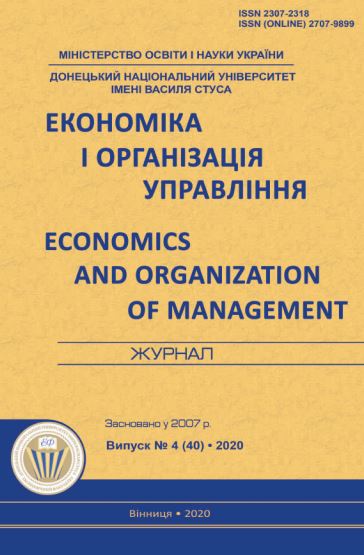Modeling of the convergence process of South-East European countries with EU countries
DOI:
https://doi.org/10.31558/2307-2318.2020.4.5Keywords:
convergence; countries of South-Eastern Europe; EU; regionalization of economic relations; cluster analysisAbstract
The paper analyzes the problems of convergence of the countries of South-Eastern Europe with the EU countries. To model the process of convergence of Southeast European countries with EU countries, a set of six indicators of EU countries (Current Account, Employment, FDI in stock, Financial account, GDP rate, Innovations, Investments, Productivity, real income per capita) was selected and used. method of multidimensional statistical analysis - the method of clustering, ie the division of the population into homogeneous clusters (groups). Since cluster analysis, like any multifactor analysis, gives a more accurate division of the population compared to a single-factor grouping, it is used to unite the EU countries on selected indicators. Five countries were selected for the study - Bulgaria, Croatia, Cyprus, Romania and Slovenia, which joined the EU in the period from 2004 to 2013. The purpose of the cluster analysis was to identify the closest affiliation of the selected five countries to a particular cluster of EU countries. The analysis was conducted for the period from 2003 to 2014, which corresponds to the period of accession of the countries selected for the study to the European Union. The analysis showed the ambiguity and uneven impact of integration processes on the convergence of macroeconomic indicators of the five new members. It should be noted that Bulgaria demonstrates close ties with EU countries in 6 out of 9 surveyed indicators. Bulgaria and Croatia have shown a high dependence on EU indicators and a corresponding convergence in employment, GDP growth, production, investment and real income. The highest convergence with the EU-15 in terms of balance of payments - current and financial accounts was shown by Slovenia, in terms of accumulated investment potential - Slovenia, Romania and Croatia. The obtained results allow concluding about the uneven but gradual convergence of the new EU members with other members of the group, as well as the overall positive impact of the synergy of regional integration processes on the formation of their investment potential.
References
Р.Бемс, Ф.Шеллекенс (2007), Фінанси і конвергенція :. Що попереду для Європи з ринком, що формується? Робочий документ МВФ Ні 07/244.
Г.Д.Демекас. і ін (2005), Прямі іноземні інвестиції в Південно-Східній Європі: Як (і скільки) може допомогти політика? Робочий документ МВФ Ні 05/110.
Конференція Організації Об'єднаних Націй з торгівлі та розвитку (2020), World Investment Report 2020.
World Bank Indicators. URL: https://data.worldbank.org/indicator

